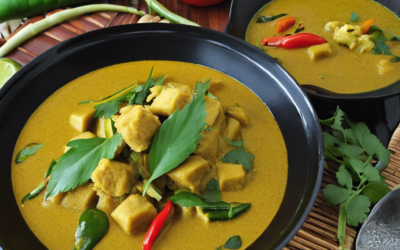Dumplings, those small stuffed bites cooked by steaming, are an iconic dish of Chinese cuisine, known and loved worldwide. But do you really know everything about these steamed dumplings? From their preparation to their consumption, and their history and cultural significance, let’s dive into the world of Chinese dumplings to become a master!
A for “À la vapeur” (Steamed): The traditional cooking method for dumplings is steaming, which gives them their characteristic soft and tender texture.
B for “Boulettes de viande” (Meatballs): Dumplings can be stuffed with a variety of ingredients, but minced meat, often pork or beef, is a key ingredient. These finely seasoned meatballs are then wrapped in dough.
C for “Chinois” (Chinese): Dumplings originated in China and have become a quintessential dish of Chinese cuisine. Their popularity has spread throughout Asia and the entire world.
D for “Dim Sum”: Dim sum is a Cantonese term referring to a style of Chinese cuisine that includes various small dishes, with dumplings being an essential part. Dim sum is often enjoyed as brunch or a late lunch.
E for “Enveloppe” (Wrapper): The dough that surrounds the filling is crucial for dumplings. It must be thin, elastic, and able to withstand steaming without tearing. Preparing the dough is an art in itself, requiring precision and patience.
F for “Farce” (Filling): The filling of dumplings can vary based on preferences and available ingredients. Classic options include pork, beef, chicken, shrimp, as well as vegetables like cabbage and mushrooms. Spices and seasonings such as ginger, garlic, and scallions add flavor.
G for “Gathering”: The preparation of dumplings is often a communal activity. Families and friends gather to make and fold dumplings together, turning the kitchen into a joyful and collaborative affair.
H for “Histoire” (History): Although the exact origins of dumplings are unknown, it is believed they evolved from similar dishes in Central Asia, introduced to China via the Silk Road. Dumplings have become an essential part of Chinese cuisine and culture.
I for “Ingéniosité” (Ingenuity): The shapes and folds of dumplings vary. From simple half-moons to complex pleats, each style has its name and charm. Creativity is an essential part of dumpling making, as each family develops its techniques and recipes.
J for “Jiaozi”: Jiaozi is a Chinese term for a type of dumplings popular in northern China. They usually have a half-moon shape and can be steamed or fried.
K for “Kuaile” (Happy in Mandarin): Dumplings are often associated with joy and celebration in China. They are eaten during festivals and family gatherings, symbolizing good fortune and prosperity.
L for “Love”: Making dumplings is an act of love. The meticulousness and time invested in their preparation make them a special dish, often made for loved ones.
M for “Méthodes de cuisson” (Cooking Methods): While steaming is the traditional method, dumplings can also be fried, boiled, or pan-fried. Each method gives dumplings a unique texture and flavor.
N for “Noms” (Names): Dumplings have many names in China, each reflecting a different region or style. Besides jiaozi, other common names include guotie, wontons, and shaomai.
O for “Outils” (Tools): Certain tools are useful for making dumplings. A rolling pin, a dumpling knife, and dumpling molds can facilitate the process, although more experienced chefs can do without these tools.
P for “Plats d’accompagnement” (Side Dishes): Dumplings are often served with a variety of sauces and dips to enhance their flavor. Soy sauce, chili vinegar, and garlic sauces are common accompaniments that add a tasty touch.
Q for “Quantité” (Quantity): Dumplings are usually made in large quantities because they are considered a generous and comforting dish. Leftovers can be steamed or fried again, making them an excellent meal for the following days.
R for “Raviolis” (Ravioli): Dumplings are often described as ravioli because they share a similar structure, with a filling wrapped in dough. However, dumpling dough is usually thinner and more elastic than Italian ravioli.
S for “Santé” (Health): Dumplings are considered a relatively healthy dish due to their steaming method, which does not require large amounts of oil. They are also often filled with vegetables, making them a healthier option than other fried dishes.
T for “Traditions” (Traditions): Dumplings are deeply rooted in Chinese culture and traditions. They are eaten during festive events such as the Chinese New Year, where they symbolize luck and wealth.
U for “Universel” (Universal): The versatility of dumplings makes them a dish that appeals to all tastes and dietary preferences. The filling options are limitless, meaning everyone can enjoy this delicious delight.
V for “Variété” (Variety): Besides meat and vegetables, dumplings can also be stuffed with fish, seafood, or even sweet flavors for desserts. The variety of dumplings reflects the diversity of Chinese cuisine.
W for “Won Tons”: Wontons are a type of Chinese dumplings resembling small bags. They are often served in soup or fried and are particularly popular in Cantonese cuisine.
X for “Xi” (West in Mandarin): Although dumplings originated in eastern China, their popularity has spread across the country and even to the west. Each region has developed its unique variations and styles of dumplings.
Y for “Yin et Yang”: The Chinese philosophy of yin and yang also applies to dumplings. The combination of the dough (yin) and the filling (yang) creates a harmonious balance of textures and flavors.
Z for “Zest”: Chinese cuisine is known for its bold flavors and pronounced aromas, and dumplings are no exception. Spices and herbs add zest to every bite, making dumplings irresistibly delicious.
Mastering the art of Chinese steamed dumplings takes time and practice, but the result is worth it. So, dive into this fascinating culinary world and become a dumpling master! Bon appétit!













